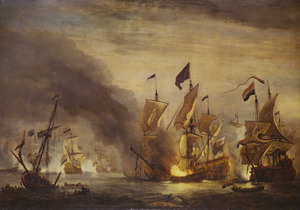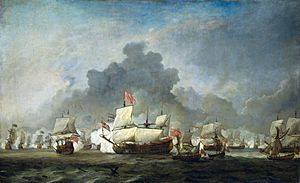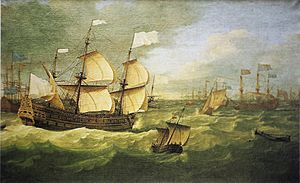Battle of Solebay facts for kids
Quick facts for kids Battle of Solebay |
|||||||
|---|---|---|---|---|---|---|---|
| Part of the third Anglo-Dutch War | |||||||
 The Burning of the Royal James at the Battle of Solebay, 28 May 1672 by Willem van de Velde the Younger |
|||||||
|
|||||||
| Belligerents | |||||||
| Commanders and leaders | |||||||
| Strength | |||||||
| 61 ships of the line, 14 frigates, 36 fire ships, and a number of smaller ships 4,500 guns 20,000 men |
85-95 War ships, 30 fire ships 6,200 guns 40,000 men |
||||||
| Casualties and losses | |||||||
|
1 ship destroyed, 1 captured ≈1600 sailors killed |
4 ships destroyed ≈2500 sailors killed |
||||||
The Battle of Solebay was a big naval battle. It happened on June 7, 1672. This was the very first battle of the Third Anglo-Dutch War.
The battle took place near Solebay, which is now called Southwold Bay, in England. A Dutch fleet surprised the English and French fleets. These fleets were anchored there and not ready for a fight. The battle stopped the English and French from invading the Dutch Republic by sea. It also made the Dutch people feel much more hopeful.
The Battle Begins

The Dutch fleet had 75 warships. They also had about 20,738 men and 4,484 cannons. Their commanders were Lieutenant-Admirals Michiel de Ruyter, Adriaen Banckert, and Willem Joseph van Ghent.
They surprised the combined English and French fleet. This fleet had between 85 and 95 warships. It also had 34,496 men and 6,018 cannons. The Allied fleet was anchored in Solebay, off the coast of Suffolk, England.
The English commander, the Duke of York, and the French commander, Vice-Admiral Comte Jean II d'Estrées, had a plan. They wanted to block Dutch ships in their home ports. This would stop Dutch trade in the North Sea.
The Dutch had tried to attack earlier. A small group of ships sailed up the Thames River. But the fort there was too strong. The main Dutch fleet arrived too late to stop the English and French fleets from joining up. So, the Dutch fleet followed the Allied ships north. The Allied fleet then stopped at Solebay to get supplies.
On June 7, the Dutch fleet suddenly appeared. It was early in the morning. The Allied fleet was completely surprised and became disorganized. The Dutch had the "weather gauge." This means they had the advantage of the wind.
The Fight Continues
The French fleet, led by d'Estrées, sailed south. They were followed by 15 Dutch ships. The French mostly fired from far away. Their ship Superbe was badly damaged. About 450 French sailors were killed or hurt.
This left the main Dutch fleet to fight the English. The English had a very hard time. They struggled to sail against the wind to get their ships ready. The Duke of York had to move his flag twice. His first two flagships, Prince and St Michael, were too damaged to continue. He finally moved to the London.
De Ruyter's flagship, De Zeven Provinciën, fought the Prince for two hours. The Prince was badly damaged. Cornelis de Witt, a Dutch leader, was with De Ruyter. He bravely stayed on the main deck. Half of his guards standing near him were killed or wounded.
Admiral Edward Montagu, 1st Earl of Sandwich, commanded the English ship Royal James. His ship was attacked fiercely by Lieutenant-Admiral Van Ghent. Van Ghent was killed by flying metal pieces during the fight.
Then, a Dutch captain named Jan van Brakel attacked the Royal James. His ship, Groot Hollandia, hit the Royal James over and over. Lord Sandwich thought about giving up. But he decided it was not honorable to surrender to a low-ranking captain. He ordered smaller boats to board the Groot Hollandia. Many English sailors jumped onto the Dutch ship. Van Brakel had to cut his ship free and retreat.
The Royal James then drifted away, sinking. Several fire ships attacked it. These were ships filled with flammable materials. The Royal James managed to sink two of them. But a third fire ship, Vrede, set it on fire. The Royal James burned, and many sailors died. Admiral Sandwich and his son-in-law drowned trying to escape. His body was later found.
Later in the afternoon, the wind changed. This gave the English the advantage. The Dutch fleet then pulled back.
Outcome of the Battle
Both sides suffered heavy losses. One Dutch ship, the Jozua, was destroyed. Another, the Stavoren, was captured. A third Dutch ship blew up by accident after the battle. Two English ships were sunk, including the Royal James. Two French ships were also sunk. Many fire ships were lost too. The battle ended when the sun set.
Even though both sides lost ships, the battle was a victory for the Dutch. It stopped the English and French from blocking Dutch ports. It also prevented them from landing troops on the Dutch coast. This was a very important win for the Dutch.
The fleets met again in 1673 at the Battle of Schooneveld.
See also
- Seven ships of the Royal Navy have been named HMS Solebay after this battle.


